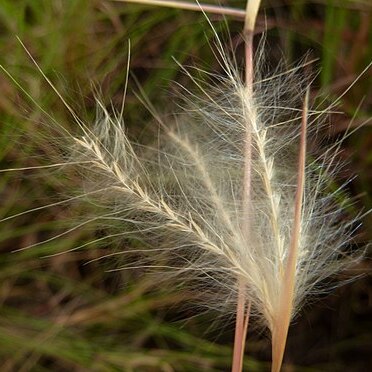Densely tufted perennial, 200-900 mm high; culms much branched above, tinged reddish. Leaf blade 40-200 x 1-3 mm; sheaths shortly auriculate; ligule a minutely fimbriate membrane. Inflorescence digitate, plumose, of 2-5 racemes; pedicels and internodes filiform, white silky hairs 5-10 mm long on margins; sessile spikelets are accompanied by a hairy empty pedicel in place of pedicelled spikelet. Sessile spikelet 2-3 mm long, glabrous; lower glume deeply and narrowly grooved; upper glume flat, awnless. Florets 2; lower floret reduced to a lemma, awnless; upper floret bisexual, lemma entire or minutely lobed, awn 12-18 mm long, flexuous, glabrous. Pedicellate spikelets absent. Flowering time Nov.-May.
Tufted perennial; culms 40–100 cm. high.. Leaf-blades 4–20 cm. long, 1–3 mm. wide, folded, abruptly acute.. Inflorescence of digitate (3–6-nate) racemes loosely gathered into a false panicle; racemes 2–4 cm. long, plumose; internodes and pedicels filiform, arcuate, plumose with hairs 7–10 mm. long.. Sessile spikelet 2–3 mm. long, with a short callus; lower glume linear, concave, thin and nerveless between the keels, glabrous, wingless; upper glume awnless; upper lemma bilobed for 1/4–1/2 its length, with a flexuous awn 12–18 mm. long.. Pedicelled spikelet suppressed.
Perennial; up to 0.9 m high; densely tufted. Leaf blades 40-200 x 4 mm. Flowers: a complex; false panicle; plumose; internode and pedicel hairs at least as long as sessile spikelets; racemes 2-5 per spathe; with white silky hairs twice as long as spikelets; spikelets 2-3 mm long; all sessile; accompanied by a hairy empty pedicel; silky plumose; of 2-6 flowering branches; lower glume of sessile spikelets deeply and narrowly grooved.
Perennial, densely tufted, up to 0.9 m high. Leaf blades 40-200 mm long, up to 4 mm wide. Spikelets 2-3 mm long (all sessile, accompanied by a hairy empty pedicel). Inflorescence plumose, of 2-6 flowering branches; racemes 2-5 per spathe, with white silky hairs twice as long as spikelets; lower glume of sessile spikelets deeply and narrowly grooved.
Sessile spikelets 2–5.5 mm long, glabrous, often reddish; inferior glume with a broad median groove, glabrous; superior glume ± flat on the back; superior lemma entire or minutely bidentate; awn flexuous, 7–22 mm long, often somewhat inconspicuous, often reddish; anthers 0.3–1.8 mm long, straw-coloured to reddish.
Racemes 2.5–4 cm long, in open subdigitate groups of (2)3–5, plumose, zig-zag, exserted from the spatheole at maturity; peduncles longer than the racemes; internodes and pedicels very delicate, filiform, ciliate with silky hairs 5–10(11) mm long on both margins.
Leaves glabrous except for the ligule area; sheath shortly auriculate at the top; ligule a fimbriate membrane, 0.5–1.5 mm long; laminas 2–50 cm × 1.2–4 mm, flat or folded, abruptly acute at the apex and mucronate.
Perennial to 1 m. Leaves linear. Spikelets in 2-5 racemes per spathe, with white-silky hairs twice as long as spikelets, pedicellate spikelet vestigial, sessile spikelet awned.
Delicate or ± robust, caespitose perennial; culms up to 250 cm high, erect, much branched above, tinged with red.
Pedicelled spikelets absent or reduced to a sterile glume up to 3 mm long.

